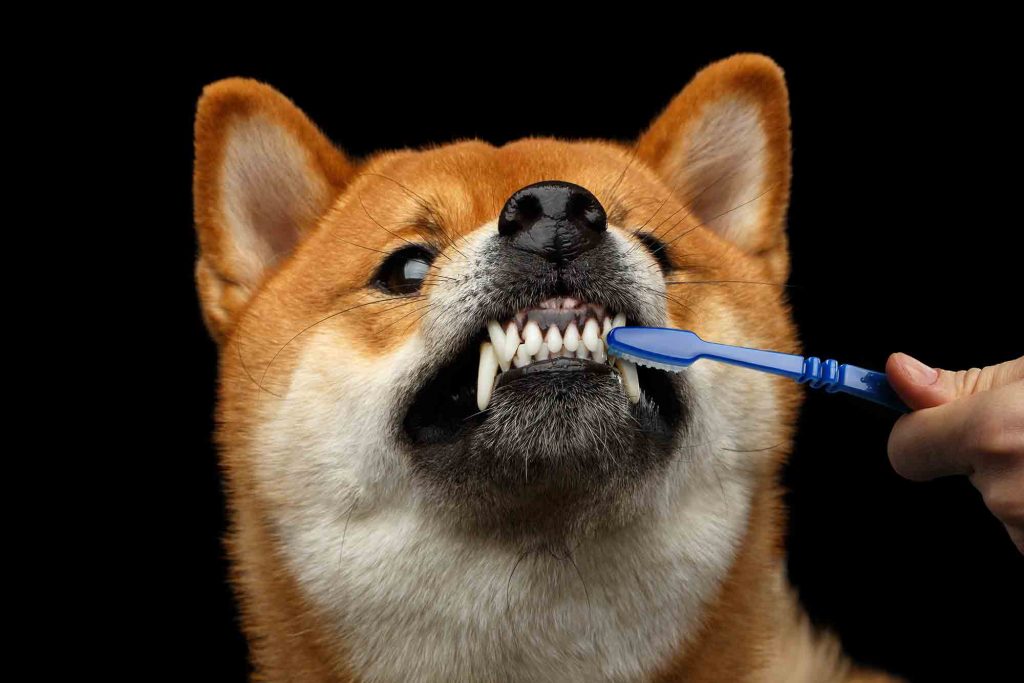Why You Should Brush Your Pet’s Teeth

There are several reasons why you should brush your pet’s teeth. Just like us, our pets’ teeth develop plaque, and have bad breath. Also like us, the lack of proper dental care leads to dental disease.
A 2016 poll by Ipsos found that 43% of dog owners never brush their dog’s teeth. 73% of cat owners say they never brush their cat’s teeth.
Excuses for Not Brushing
The most common reasons pet owners avoid brushing are difficulty, inconvenience, and lack of knowledge. However, neglecting dental care can lead to periodontal disease.
We’re Here To Help
Brushing your pet’s teeth may seem like an impossible task, but with patience and consistency, most pets can learn to tolerate—or even enjoy—daily dental care.
Pet Tooth Brushing Basics
Pet Toothbrush
Use a pet toothbrush that’s appropriate for the size of your pet’s mouth. Many pet owners prefer using a finger brush for easier handling and better control.
Pet Toothpaste
Never use human toothpastes. They contain ingredients that are harmful to pets if swallowed. Pet toothpastes come in different flavors: poultry, beef, and seafood.
Regular Dental Exams
Regular professional dental exams and cleanings are essential for preventive care.
Start Early
You can start brushing your pet’s teeth at any age. Ideally, it’s best to begin when they’re a puppy or kitten. If your pet is older, a great time to start is after a professional dental cleaning, as their mouth will be free of tartar, and daily brushing will help maintain that.
How to Brush Your Pet’s Teeth
View our step-by-step video on how to brush your pet’s teeth.
Try the following tips for pet tooth brushing:
- Allow your pet to sniff and examine the toothbrush and toothpaste you’ve selected.
- Get your pet used to having its mouth touched by lifting the lips and gently rubbing their teeth and gums with your finger. Gradually introduce a finger covered in toothpaste, then try the toothbrush/toothpaste combo (or finger brush if your pet isn’t tolerating a toothbrush).
- Start slowly. Stop if your pet becomes agitated. With practice and patience, the agitation should subside as your pet gets used to the process. Aim for a goal of 30 seconds of brushing on the upper and lower teeth, on each side of the mouth.
- Brush your pet’s teeth gently in a circular motion, making sure to stay along the gumline.
- You only need to brush the outer surface of the teeth, including the front.
- Licking and chewing the toothpaste while you’re brushing is normal pet behavior. It is also not unusual for a pet to keep its upper and lower teeth together while being brushed. In this case, gently maneuver the brush around so you can reach all of the teeth.
- Be sure to reach the brush all the way to the teeth in the back. They can be easy to miss.
- End each brushing session with praise and a treat to create a positive association for your pet. You can also give the treat prior to brushing, instead of after, to generate excitement for brushing time.
- Brush once a day, preferably, after your pet’s last meal — this will remove the sticky plaque that has formed during the day.
Bonding Experience
Treat tooth brushing as a bonding experience with your pet. Approach each session with positivity and patience, and keep practicing! Over time, brushing will become a regular part of your pet’s routine, leading to less tartar buildup, fresher breath, healthier gums and teeth, and overall improved wellness for your pet.
Dental Care at Lone Tree Veterinary Medical Center
At Lone Tree Veterinary Medical Center, we take the dental health of our patients seriously. If you notice any signs of a dental problem, such as foul breath, bleeding/swollen gums, or pain while eating, don’t hesitate to contact us. We are here for you and your pet every day.



